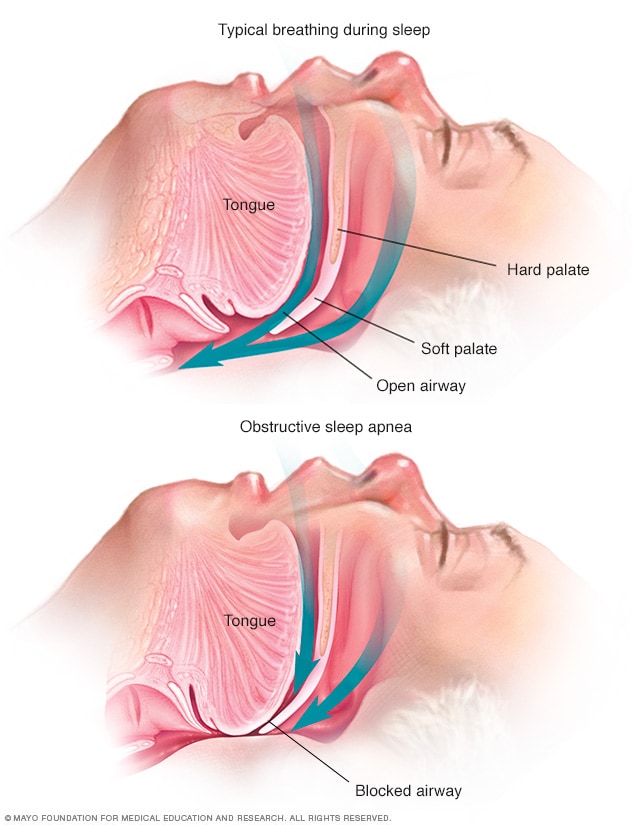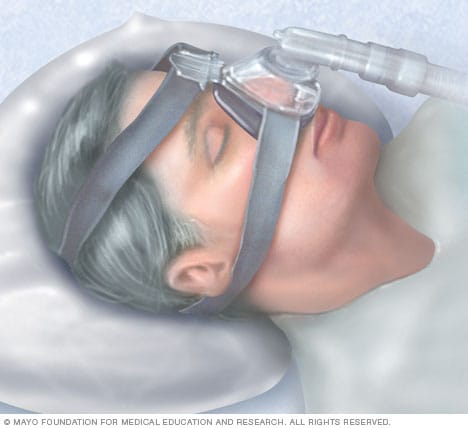September 10, 2020
SNORING AND OBSTRUCTIVE SLEEP APNEA
Sleep apnea is a potentially serious sleep disorder in which breathing repeatedly stops and starts. If you snore loudly and feel tired even after a full night’s sleep, you might have sleep apnea.
The main types of sleep apnea are:
- Obstructive sleep apnea, the more common form that occurs when throat muscles relax.
- Central sleep apnea, which occurs when your brain doesn’t send proper signals to the muscles that control breathing
- Complex sleep apnea syndrome, also known as treatment-emergent central sleep apnea, which occurs when someone has both obstructive sleep apnea and central sleep apnea
If you think you might have sleep apnea, see your doctor. Treatment can ease your symptoms and might help prevent heart problems and other complications
Symptoms
- Loud snoring
- Episodes in which you stop breathing during sleep — which would be reported by another person
- Gasping for air during sleep
- Awakening with a dry mouth
- Morning headache
- Difficulty staying asleep (insomnia)
- Excessive daytime sleepiness (hypersomnia)
- Difficulty paying attention while awake
- Irritability
Obstructive sleep apnea
 Obstructive sleep apneaOpen pop-up dialog box
Obstructive sleep apneaOpen pop-up dialog box
This occurs when the muscles in the back of your throat relax. These muscles support the soft palate, the triangular piece of tissue hanging from the soft palate (uvula), the tonsils, the side walls of the throat and the tongue.
When the muscles relax, your airway narrows or closes as you breathe in. You can’t get enough air, which can lower the oxygen level in your blood. Your brain senses your inability to breathe and briefly rouses you from sleep so that you can reopen your airway. This awakening is usually so brief that you don’t remember it.
You might snort, choke or gasp. This pattern can repeat itself five to 30 times or more each hour, all night, impairing your ability to reach the deep, restful phases of sleep.
Risk factors
- Excess weight. Obesity greatly increases the risk of sleep apnea. Fat deposits around your upper airway can obstruct your breathing.
- Neck circumference. People with thicker necks might have narrower airways.
- A narrowed airway. You might have inherited a narrow throat. Tonsils or adenoids also can enlarge and block the airway, particularly in children.
- Being male. Men are two to three times more likely to have sleep apnea than are women. However, women increase their risk if they’re overweight, and their risk also appears to rise after menopause.
- Being older. Sleep apnea occurs significantly more often in older adults.
- Family history. Having family members with sleep apnea might increase your risk.
- Use of alcohol, sedatives or tranquilizers. These substances relax the muscles in your throat, which can worsen obstructive sleep apnea.
- Smoking. Smokers are three times more likely to have obstructive sleep apnea than are people who’ve never smoked. Smoking can increase the amount of inflammation and fluid retention in the upper airway.
- Nasal congestion. If you have difficulty breathing through your nose — whether from an anatomical problem or allergies — you’re more likely to develop obstructive sleep apnea.
- Medical conditions. Congestive heart failure, high blood pressure, type 2 diabetes and Parkinson’s disease are some of the conditions that may increase the risk of obstructive sleep apnea. Polycystic ovary syndrome, hormonal disorders, prior stroke and chronic lung diseases such as asthma also can increase risk.
Central sleep apnea
This less common form of sleep apnea occurs when your brain fails to transmit signals to your breathing muscles. This means that you make no effort to breathe for a short period. You might awaken with shortness of breath or have a difficult time getting to sleep or staying asleep.
RISK FACTORS
- Being older. Middle-aged and older people have a higher risk of central sleep apnea.
- Being male. Central sleep apnea is more common in men than it is in women.
- Heart disorders. Having congestive heart failure increases the risk.
- Using narcotic pain medications. Opioid medications, especially long-acting ones such as methadone, increase the risk of central sleep apnea.
- Stroke. Having had a stroke increases your risk of central sleep apnea or treatment-emergent central sleep apnea.
Diagnosis
An evaluation often involves overnight monitoring at a sleep center of your breathing and other body functions during sleep. Home sleep testing also might be an option. Tests to detect sleep apnea include:
- Nocturnal polysomnography. During this test, you’re hooked up to equipment that monitors your heart, lung and brain activity, breathing patterns, arm and leg movements, and blood oxygen levels while you sleep.
- Home sleep tests. Your doctor might provide you with simplified tests to be used at home to diagnose sleep apnea. These tests usually measure your heart rate, blood oxygen level, airflow and breathing patterns.If the results are abnormal, your doctor might be able to prescribe a therapy without further testing. Portable monitoring devices don’t detect all cases of sleep apnea, however, so your doctor might still recommend polysomnography even if your initial results are normal.
Treatment
For milder cases of sleep apnea, your doctor may recommend only lifestyle changes, such as losing weight or quitting smoking. If you have nasal allergies, your doctor will recommend treatment for your allergies.
If these measures don’t improve your signs and symptoms or if your apnea is moderate to severe, a number of other treatments are available.
Certain devices can help open up a blocked airway. In other cases, surgery might be necessary.
Therapies
- Continuous positive airway pressure (CPAP). If you have moderate to severe sleep apnea, you might benefit from using a machine that delivers air pressure through a mask while you sleep. With CPAP (SEE-pap), the air pressure is somewhat greater than that of the surrounding air and is just enough to keep your upper airway passages open, preventing apnea and snoring.Although CPAP is the most common and reliable method of treating sleep apnea, some people find it cumbersome or uncomfortable. Some people give up on theCPAP machine, but with practice, most people learn to adjust the tension of the straps on the mask to obtain a comfortable and secure fit.You might need to try more than one type of mask to find one that’s comfortable. Don’t stop using the CPAP machine if you have problems. Check with your doctor to see what changes can be made to increase your comfort.Additionally, contact your doctor if you’re still snoring or begin snoring again despite treatment. If your weight changes, the pressure settings of the CPAP machine might need to be adjusted.

- Other airway pressure devices. If using a CPAP machine continues to be a problem for you, you might be able to use a different type of airway pressure device that automatically adjusts the pressure while you’re sleeping (auto-CPAP). Units that supply bilevel positive airway pressure (BPAP) also are available. These provide more pressure when you inhale and less when you exhale.
- Oral appliances. Another option is wearing an oral appliance designed to keep your throat open. CPAP is more reliably effective than oral appliances, but oral appliances might be easier to use. Some are designed to open your throat by bringing your jaw forward, which can sometimes relieve snoring and mild obstructive sleep apnea.A number of devices are available from your dentist. You might need to try different devices before finding one that works for you.Once you find the right fit, you’ll need to follow up with your dentist repeatedly during the first year and then regularly after that to ensure that the fit is still good and to reassess your signs and symptoms.
- Treatment for associated medical problems. Possible causes of central sleep apnea include heart or neuromuscular disorders, and treating those conditions might help.
- Supplemental oxygen. Using supplemental oxygen while you sleep might help if you have central sleep apnea. Various forms of oxygen are available with devices to deliver oxygen to your lungs.
- Adaptive servo-ventilation (ASV). This more recently approved airflow device learns your normal breathing pattern and stores the information in a built-in computer. After you fall asleep, the machine uses pressure to normalize your breathing pattern and prevent pauses in your breathing.ASV appears to be more successful than other forms of positive airway pressure at treating complex sleep apnea in some people. However, it might not be a good choice for people with predominant central sleep apnea and advanced heart failure.
Surgery
Surgery is usually only an option after other treatments have failed. Generally, at least a three-month trial of other treatment options is suggested before considering surgery. However, for a small number of people with certain jaw structure problems, it’s a good first option.
Surgical options might include:
Nasal Septal Surgery with Inferior turbinate Reduction
- Tissue removal. During this procedure (uvulopalatopharyngoplasty), your doctor removes tissue from the rear of your mouth and top of your throat. Your tonsils and adenoids usually are removed as well.This type of surgery might be successful in stopping throat structures from vibrating and causing snoring. It’s less effective than CPAP and isn’t considered a reliable treatment for obstructive sleep apnea.Removing tissues in the back of your throat with radiofrequency energy (radiofrequency ablation) might be an option if you can’t tolerate CPAP or oral appliances.
- Tissue shrinkage. Another option is to shrink the tissue at the rear of your mouth and the back of your throat using radiofrequency ablation. This procedure might be used for mild to moderate sleep apnea. One study found this to have effects similar to that of tissue removal, but with fewer surgical risks.
- Jaw repositioning. In this procedure, your jaw is moved forward from the remainder of your face bones. This enlarges the space behind the tongue and soft palate, making obstruction less likely. This procedure is known as maxillomandibular advancement.
- Implants. Soft rods, usually made of polyester or plastic, are surgically implanted into the soft palate after you’ve received local anesthetic. More research is needed to determine how well implants work.
- Nerve stimulation. This requires surgery to insert a stimulator for the nerve that controls tongue movement (hypoglossal nerve). The increased stimulation helps keep the tongue in a position that keeps the airway open. More research is needed.
- Creating a new air passageway (tracheostomy). You may need this form of surgery if other treatments have failed and you have severe, life-threatening sleep apnea. In this procedure, your surgeon makes an opening in your neck and inserts a metal or plastic tube through which you breathe.You keep the opening covered during the day. But at night you uncover it to allow air to pass in and out of your lungs, bypassing the blocked air passage in your throat.
Other types of surgery may help reduce snoring and contribute to the treatment of sleep apnea by clearing or enlarging air passages:

 Obstructive sleep apneaOpen pop-up dialog box
Obstructive sleep apneaOpen pop-up dialog box